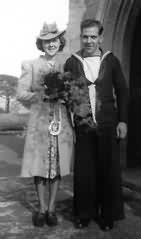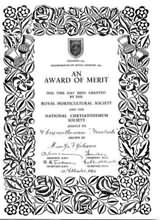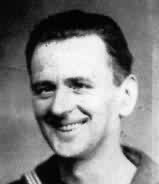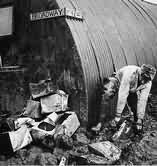|
HMS Firedrake |
|
Chief Petty Officer Peter Armstrong The Firedrake's Coxswain |
Chief Petty Officer Peter George Armstrong BEM the coxswain of Firedrake. Joined the Navy as a boy at fourteen by getting his local vicar to sign his entrance forms, because his parents did not want him to join, Peter told the vicar his parents could not read or write so the vicar signed the forms. At thirteen years of age Peter was South East London School Boys Swimming Champion. He was awarded the British Empire Medal for heroism when he went aboard the French destroyer Maillé Brézé to administer first-aid to the injured and dying following a torpedo exploding in her fo’c’sle on the Clyde, it had gone off accidentally running along her deck into the fo’c’sle the ship sank with twenty six still trapped inside. There’s a book by A. D. Devine entitled, Destroyers War, which tells of the incident. Peters Wife Margaret (Peggy) was head waitress at the Cumberland Hotel in London before the war so Peter was often seen in the Cumberland which brings me to the next story. |
|
When the Firedrake was in the Mediterranean on 18th October
1940, with the help of a Flying boat of 202 squadron RAF and
HMS Wrestler, they bought to the surface and sunk the Italian
submarine Durbo, before the sub went to the bottom the crew
was taken prisoner, one of the Italian prisoners came running
up to Peter and through his arms around him. Before the war
this Italian had worked at the Cumberland as a waiter so knew
Peter and his wife very well. He told Peter that when the war
started he had gone back to Italy and been called up and had
ended up on the Durbo. It certainly is a small world. |
|
When
Peter was a boy he used to push his cousin Margaret in a pram.
Both had fair hair and blue eyes. Peter was seven years older
than Margaret. Eventually they became sweethearts. When he was
fourteen Peter went to sea. Margaret became a waitress. She was
often among those selected for Buckingham Palace garden parties.
Thousands knew her smile, for at one occasion she had been chosen
as a model in a toothpaste advertisement. In July 1937 Peter and
Margaret were married. |
Mrs Armstrong and her daughter Margaret Ann |
|
The
Chrysanthemum called Firedrake
|
 |
Ron
Slack Stoker 1. |
 |
| After the war Ron’s father-in-law Joe Johnson who was an accomplished chrysanthemum grower in Derbyshire, produced a new flower in honour of the ship and of his son-in-law Ron. It won the gold medal and an Award of Merit at the Royal Horticultural Society show in London in September 1945 so he named the new flower Firedrake. In the Chrysanthemums catalogue of 1947 it gives the description as: a real beauty for cutting and for vase work; not a large bloom, but a very effective shade of light terracotta throughout the whole of the flower; a good even grower on upright stems, small foliage. A.M.. J.E.F.C.A.M., Wisley. 2˝ft. September. |
|
U12
Never Claimed
|
| On
Wednesday 6th September 1939 at 07.30 in the morning three days
after the start of world war two, Firedrake was heading north through
the English channel, the Asdic operator below reported with a sudden
urgency of a submarine contact. On the bridge they heard the indications
repeated on the loud speaker, instantly they turned towards it.
In peace time they had done this a hundred times, racing at imaginary
targets, thrusting at the invisible buffs (the little red fisherman's
buoys towed by a target submarine). But this was war, somewhere under the grey water there was an enemy ready and waiting, they came closer and closer, soon they were over the target. In the ordered ritual of the attack, the quiet urgent orders were given, and the pattern of depth charges was dropped. They raced on, then astern of them, across the broad white roadway of their wake, the sea broke suddenly in a great explosion. Under their feet the ship jerked a little, and again the sea broke first a shuddering dislocation of the surface, then the sledge hammer blow of the explosion, then the enormous uprushing thunder of the spray... The attack went through its appointed course. When it was done there was a patch of oil upon the water, oil that spread, and with the movement of the tide trailed slowly in a long and shining pathway on the surface of the sea. They saw no wreckage, they recovered no bodies. So they do not claim that submarine. But Germany a little later, admitted the loss of U12 at about that time, and in approximately those waters. By A.D.Divine D.S.M. |
 |
John Starrs (stoker) joined the Navy in 1940, he survived the sinking of HMS Firedrake on the 16/17th December 1942, was picked up by HMS Sunflower and taken to Argentia Newfoundland, after a brief rest, John went back to Chatham and was there for a while, then he was posted to the Naval Base at Reykjavik (Iceland) and there he stayed till the end of the war. After the war he went back to living in Tollcross Glasgow in Scotland and lived there happily with his thirteen grandchildren till he was 78 years of age. Photo right: American soldier in the mud of Reykjavik. |
 |
|
Other
Pages Below
|